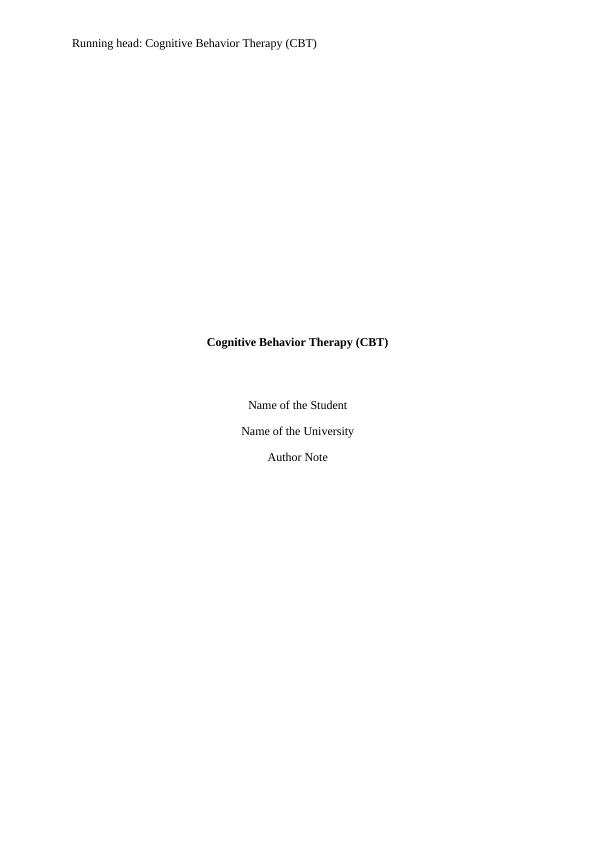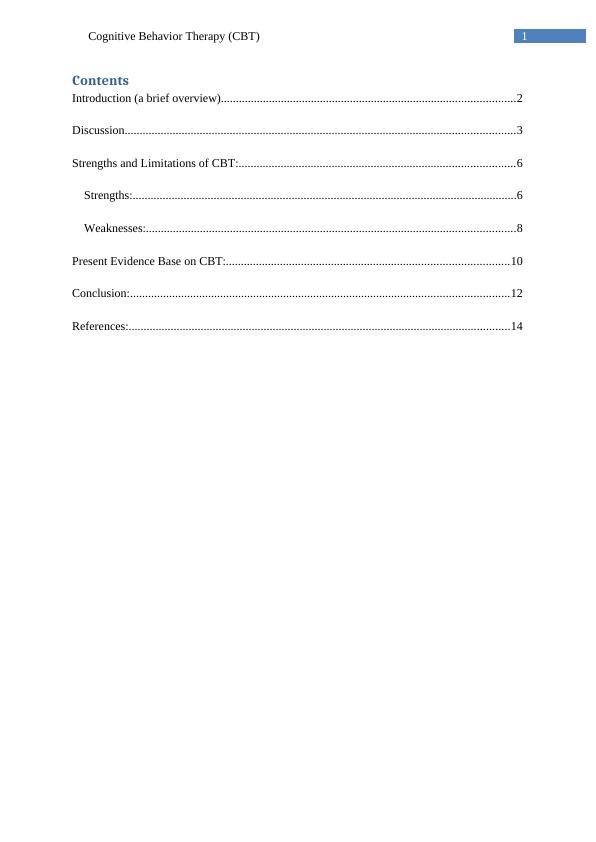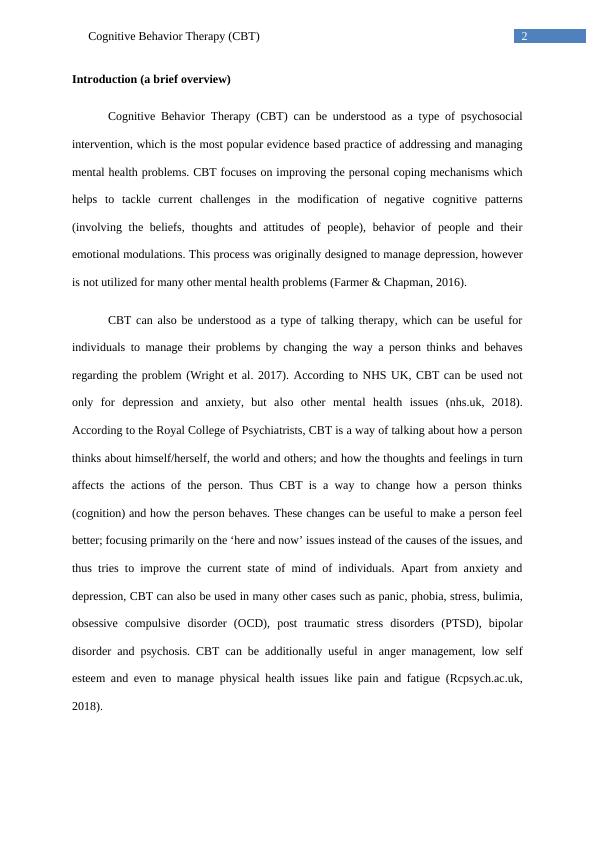Cognitive Behavior Therapy (CBT) - An Overview, Strengths and Limitations
Added on 2023-06-13
18 Pages5245 Words363 Views
Running head: Cognitive Behavior Therapy (CBT)
Cognitive Behavior Therapy (CBT)
Name of the Student
Name of the University
Author Note
Cognitive Behavior Therapy (CBT)
Name of the Student
Name of the University
Author Note

1Cognitive Behavior Therapy (CBT)
Contents
Introduction (a brief overview)..................................................................................................2
Discussion..................................................................................................................................3
Strengths and Limitations of CBT:............................................................................................6
Strengths:................................................................................................................................6
Weaknesses:...........................................................................................................................8
Present Evidence Base on CBT:..............................................................................................10
Conclusion:..............................................................................................................................12
References:...............................................................................................................................14
Contents
Introduction (a brief overview)..................................................................................................2
Discussion..................................................................................................................................3
Strengths and Limitations of CBT:............................................................................................6
Strengths:................................................................................................................................6
Weaknesses:...........................................................................................................................8
Present Evidence Base on CBT:..............................................................................................10
Conclusion:..............................................................................................................................12
References:...............................................................................................................................14

2Cognitive Behavior Therapy (CBT)
Introduction (a brief overview)
Cognitive Behavior Therapy (CBT) can be understood as a type of psychosocial
intervention, which is the most popular evidence based practice of addressing and managing
mental health problems. CBT focuses on improving the personal coping mechanisms which
helps to tackle current challenges in the modification of negative cognitive patterns
(involving the beliefs, thoughts and attitudes of people), behavior of people and their
emotional modulations. This process was originally designed to manage depression, however
is not utilized for many other mental health problems (Farmer & Chapman, 2016).
CBT can also be understood as a type of talking therapy, which can be useful for
individuals to manage their problems by changing the way a person thinks and behaves
regarding the problem (Wright et al. 2017). According to NHS UK, CBT can be used not
only for depression and anxiety, but also other mental health issues (nhs.uk, 2018).
According to the Royal College of Psychiatrists, CBT is a way of talking about how a person
thinks about himself/herself, the world and others; and how the thoughts and feelings in turn
affects the actions of the person. Thus CBT is a way to change how a person thinks
(cognition) and how the person behaves. These changes can be useful to make a person feel
better; focusing primarily on the ‘here and now’ issues instead of the causes of the issues, and
thus tries to improve the current state of mind of individuals. Apart from anxiety and
depression, CBT can also be used in many other cases such as panic, phobia, stress, bulimia,
obsessive compulsive disorder (OCD), post traumatic stress disorders (PTSD), bipolar
disorder and psychosis. CBT can be additionally useful in anger management, low self
esteem and even to manage physical health issues like pain and fatigue (Rcpsych.ac.uk,
2018).
Introduction (a brief overview)
Cognitive Behavior Therapy (CBT) can be understood as a type of psychosocial
intervention, which is the most popular evidence based practice of addressing and managing
mental health problems. CBT focuses on improving the personal coping mechanisms which
helps to tackle current challenges in the modification of negative cognitive patterns
(involving the beliefs, thoughts and attitudes of people), behavior of people and their
emotional modulations. This process was originally designed to manage depression, however
is not utilized for many other mental health problems (Farmer & Chapman, 2016).
CBT can also be understood as a type of talking therapy, which can be useful for
individuals to manage their problems by changing the way a person thinks and behaves
regarding the problem (Wright et al. 2017). According to NHS UK, CBT can be used not
only for depression and anxiety, but also other mental health issues (nhs.uk, 2018).
According to the Royal College of Psychiatrists, CBT is a way of talking about how a person
thinks about himself/herself, the world and others; and how the thoughts and feelings in turn
affects the actions of the person. Thus CBT is a way to change how a person thinks
(cognition) and how the person behaves. These changes can be useful to make a person feel
better; focusing primarily on the ‘here and now’ issues instead of the causes of the issues, and
thus tries to improve the current state of mind of individuals. Apart from anxiety and
depression, CBT can also be used in many other cases such as panic, phobia, stress, bulimia,
obsessive compulsive disorder (OCD), post traumatic stress disorders (PTSD), bipolar
disorder and psychosis. CBT can be additionally useful in anger management, low self
esteem and even to manage physical health issues like pain and fatigue (Rcpsych.ac.uk,
2018).

3Cognitive Behavior Therapy (CBT)
CBT integrates principles from cognitive and behavioral psychology, and differs from
psychotherapy (where meanings behaving each behavior are focused on). Instead, CBT is an
action oriented and problem based approach to treat specific mental health condition that has
already been diagnosed. The practice is also based on the understanding that distorted
through and maladaptive behavior has a crucial part in the persistence of mental health
problems and psychological disorders and that the adverse facets of these conditions can be
lowered by changing how information is processed and through coping strategies (Hayes et
al. 2016).
The purpose of this report is to understand the process of CBT, the mental health
conditions where CBT can be utilized, analyze its strengths and weaknesses and key
outcomes of the process.
Discussion
CBT generally comprises of 10- 20 sessions, which can last 1 hour each and conducted
one every week. The sessions can be individually delivered or in a family or small (focus)
group setup. In the recent years, computer programs which are internet based and assisted by
clinicians, are also used in the CBT process (Wright et al. 2017). According to the John
Hopkins Psychiatry Guide, CBT can involve different types of strategies such as:
Psycho education: Here the patients are educated on the nature of mental health
issues, helping to increase understanding of its effects on cognition and behavior
of people.
Cognitive Restructuring: This is the process of identifying; challenging and
eliminating maladaptive thinking process and incorporate adaptive, realistic and
coping thought processes.
CBT integrates principles from cognitive and behavioral psychology, and differs from
psychotherapy (where meanings behaving each behavior are focused on). Instead, CBT is an
action oriented and problem based approach to treat specific mental health condition that has
already been diagnosed. The practice is also based on the understanding that distorted
through and maladaptive behavior has a crucial part in the persistence of mental health
problems and psychological disorders and that the adverse facets of these conditions can be
lowered by changing how information is processed and through coping strategies (Hayes et
al. 2016).
The purpose of this report is to understand the process of CBT, the mental health
conditions where CBT can be utilized, analyze its strengths and weaknesses and key
outcomes of the process.
Discussion
CBT generally comprises of 10- 20 sessions, which can last 1 hour each and conducted
one every week. The sessions can be individually delivered or in a family or small (focus)
group setup. In the recent years, computer programs which are internet based and assisted by
clinicians, are also used in the CBT process (Wright et al. 2017). According to the John
Hopkins Psychiatry Guide, CBT can involve different types of strategies such as:
Psycho education: Here the patients are educated on the nature of mental health
issues, helping to increase understanding of its effects on cognition and behavior
of people.
Cognitive Restructuring: This is the process of identifying; challenging and
eliminating maladaptive thinking process and incorporate adaptive, realistic and
coping thought processes.

End of preview
Want to access all the pages? Upload your documents or become a member.
Related Documents
Effectiveness of Cognitive Behavioral Therapy (CBT) in Counsellinglg...
|8
|2543
|24
CBT and Existential Therapy: A Comparative Analysislg...
|9
|2694
|302
Cognitive Therapy | Reportlg...
|5
|1042
|17
The Cognitive-behavioral therapylg...
|7
|1731
|17
Cognitive Behavioral Therapy Case Study 2022lg...
|8
|1976
|24
Assignment on Interventions in Mental Health for Athleteslg...
|12
|782
|16
